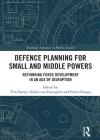Rethinking Force Development in an Age of Disruption
Routledge, London, 2024, 280 pp
Hardcover ISBN: 9781032503561
Editors: Tim Sweijs, Saskia van Genugten and Frans Osinga
Reviewed by: Adam Lockyer
In a time of rapidly changing geopolitical landscapes and increasing complexity in global security dynamics, Tim Sweijs, Saskia van Genugten and Frans Osinga’s edited volume Defence Planning for Small and Middle Powers emerges as an important contribution to the discourse on national security strategy. The editors have brought together a team of international scholars to contribute to this comparative work that includes cases from North America, Europe, the Middle East, Asia and Oceania.
The book provides a detailed, methodical analysis of countries that lack the extensive resources and global influence of great powers but that still face significant security challenges. The editors are on firm ground when pointing out that the literature on defence planning is currently skewed towards great powers, which is a significant oversight considering the pivotal role that small and middle powers often play in international politics.[1] The book is both timely and relevant, offering a nuanced examination of how small and middle powers can navigate the intricacies of modern defence planning.
The book is both conceptual and empirical. The editors have chosen to pursue a structured, focused comparison for the cases. This was a wise choice and the book is much stronger for it. Often in these kinds of volumes, the different authors of the cases are given too little structure from the research leads, which results in cases that are interesting but resist comparison. By contrast, here the contributors have been provided with a clear, tight and logical structure for their case studies. The result is a valuable cross-sectional comparison of defence planning from cases that span the globe. Specifically, the editors identified three main themes for analysis: (1) alliances, dependencies and national ambition, (2) approaches, processes, methods and techniques; and (3) military innovation strategies and outcomes.[2] From these themes, subsequent questions were established, including the extent to which the small and middle powers have engaged with other states to increase their capabilities, and the extent to which they take a constrained approach to defence planning. This structure allowed for more valuable generalisable results than alternative approaches.
The book compares 11 different cases of small and middle powers’ defence planning. From North America the book contains a chapter on Canada; from Europe there are the cases of Finland, the Netherlands and Slovakia; the Middle East is represented by Israel, Oman, Turkey and the United Arab Emirates; and Asia’s and Oceania’s cases are Australia, Indonesia and Singapore. The Australian case is provided by leading Australian strategic thinkers Dr Andrew Carr and Professor Stephan Frühling. Carr and Frühling’s chapter faithfully follows the structure outlined above, and walks readers through the evolution of Australian defence planning. They argue that Australia’s defence planning has been pragmatic but with some recurring core concepts. The chapter provides a condensed and clear overview of Australia’s defence planning, which will be useful to scholars, students and non-experts alike.
The book concludes that small and middle powers have been adapting their defence postures in response to geopolitical, technological and climate change related national security challenges.[3] The book highlights the trade-offs that confront all small and middle powers. Unlike great powers, they rarely can shape their own international environment. So they are forced to make decisions on, for example, how much diplomatic autonomy they trade away to a great power benefactor in the name of their national security.
Overall, Defence Planning for Small and Middle Powers is a significant contribution to the field of international security studies. It offers a detailed and pragmatic perspective on how smaller states plan and implement their defence strategies. The book will primarily be of interest to academics and students of defence policy, planning and strategy. It will also likely find an audience among public servants and members of the defence forces who would like to locate their enterprise within the larger enterprise of planning and force design. For those interested in understanding the unique challenges and opportunities faced by small and middle powers in the realm of defence, this book is an essential read.
Endnotes
[1] The authors are on more contentious ground when arguing that defence planning is a separate field of study to strategic studies (which they define as the use current capabilities), but this is a minor point. See Tim Sweijs, Saskia van Genugten and Frans Osinga, ‘Introduction’, in Tim Sweijs, Saskia van Genugten and Frans Osinga (eds), Defence Planning for Small and Middle Powers: Rethinking Force Development in an Age of Disruption (London: Routledge, 2024), pp. 3 and 5.
[2] Ibid., p. 7.
[3] This is interesting because a recent book on geopolitics found that it was not a major driver of force structure and modernisation among small and middle powers in the Indo-Pacific. See, Bates Gill, Adam Lockyer, Yves-Heng Lim and Andrew TH Tan, Geopolitics, Military Modernisation and the Future of the Indo-Pacific (London: Routledge, 2024).


